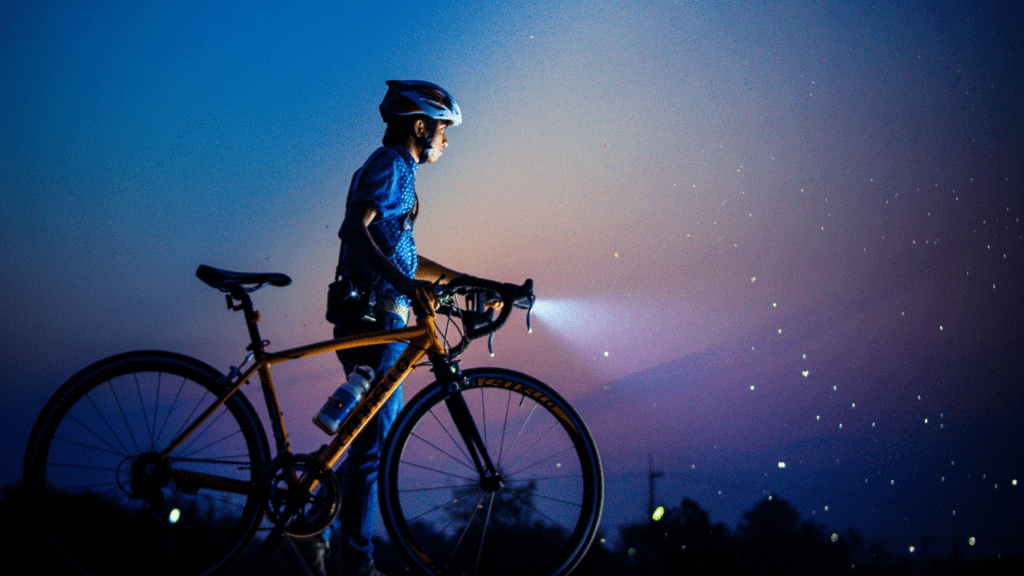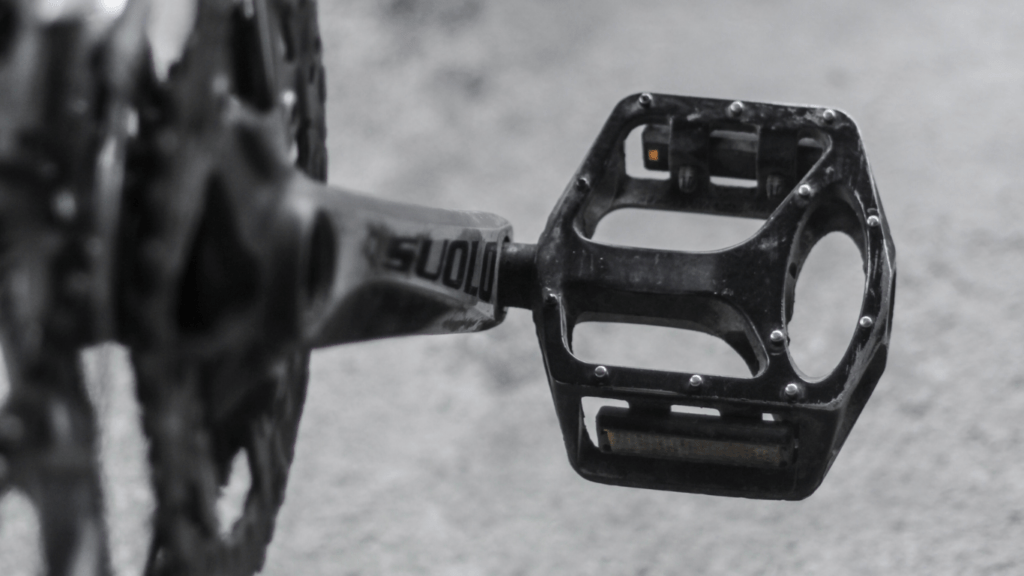Importance of Visibility for Cyclists
Staying visible is crucial for a cyclist’s safety on the road. Effective visibility helps prevent accidents and ensures a smoother ride.
Why Brightness Matters
Brightness determines how well others can see a cyclist, especially in low-light conditions. Bike lights typically range from 100 to 2,000 lumens.
For urban commuting, 100-500 lumens work well as streetlights provide some illumination. On dark trails or roads, 800-2,000 lumens offer better visibility. Reflectors complement lights by bouncing back headlights from cars.
Key Visibility Factors at Night
Several key factors influence a cyclist’s visibility at night:
- Light Positioning: Mount front lights on the handlebars and rear lights on the seat post. This setup maximizes visibility.
- Reflective Gear: Wear reflective vests, jackets, and ankle bands. These items catch light from car headlights.
- Consistent Lighting: Use steady beams and flashing modes. Steady beams illuminate the path, while flashing modes attract attention.
- Weather Conditions: In rain or fog, brighter lights (500-1,500 lumens) penetrate better, maintaining visibility.
By considering these factors, cyclists can enhance their visibility, ensuring a safer journey.
Types of Bike Lights
Different types of bike lights ensure visibility and safety in various cycling conditions. Knowing the types helps choose the right one for your needs.
Front Lights
Front lights are crucial for illuminating the path ahead and making you visible to oncoming traffic. Two common types include:
- LED Lights: LEDs provide bright, efficient lighting. They vary in brightness, with options ranging from 100 to 2,000 lumens. Rechargeable models offer convenience and long-term cost savings.
- Halogen Lights: Halogen lights offer strong brightness and are less energy-efficient than LEDs but are more affordable. These lights are suitable for short commutes and casual rides.
Rear Lights
Rear lights ensure that you’re seen from behind. They often have flashing modes to capture motorists’ attention. Popular examples are:
- LED Rear Lights: These lights offer high visibility with longer battery life. They come in both rechargeable and battery-operated versions.
- Reflective Rear Lights: Some rear lights integrate reflectors, providing an added layer of visibility when illuminated by other vehicles’ headlights.
Dynamic Lighting Options
Dynamic lighting options adjust based on surroundings to enhance safety and efficiency. Examples include:
- Smart Lights: These lights use sensors to adjust brightness according to ambient light. They often connect to smartphone apps for customization and monitoring.
- Brake-Activated Lights: These rear lights brighten when you slow down, alerting vehicles behind you. They’re especially useful in traffic where sudden stopping is frequent.
Understanding these options ensures you stay visible and safe while cycling.
Reflectors: An Essential Safety Addition
Reflectors play a crucial role in enhancing a cyclist’s visibility. By reflecting light from other sources, such as car headlights, they ensure that cyclists remain visible even if their bike lights fail.
How Reflectors Complement Lights
Reflectors and bike lights both enhance visibility, but they function differently.
While bike lights actively project light to illuminate the road, reflectors passively bounce light back to the source, increasing visibility from various angles. Reflectors provide an added layer of safety, particularly in low-light conditions, complementing the active illumination provided by bike lights.
Placement and Types of Reflectors
Proper placement optimizes the effectiveness of reflectors. For maximum visibility:
- Front Reflectors: Attached to the handlebars or front fork.
- Rear Reflectors: Positioned on the seat post or rear rack.
- Wheel Reflectors: Placed on spokes to increase side visibility.
- Pedal Reflectors: Built into pedals to enhance motion visibility.
- Standard Reflectors: Common on many bikes, in orange or red.
- Spoke Reflectors: Increase side visibility, typically on all spokes.
- Clip-on Reflectors: Easily attachable to clothing or accessories, providing versatile use.
Choosing the Right Lights and Reflectors

Selecting appropriate lights and reflectors is crucial for cyclists to stay visible on the road. Various factors and innovations influence these choices.
Factors to Consider
Cyclists must consider several factors when choosing lights and reflectors. Brightness is a key factor, as it impacts visibility. Headlights with 100 to 2,000 lumens are common, depending on riding conditions.
Ambient lighting influences your choice as well, necessitating different setups for urban versus rural areas.
Battery life impacts usability; lights with longer durations ensure continuous visibility. Mounting options also matter; handlebar, helmet, and seat post mounts offer versatile visibility angles.
Waterproof and weather-resistant features are essential for all-weather riding.
Latest Innovations in Bike Lighting
Bike lighting technology continuously evolves, offering advanced solutions for enhanced visibility. Smart lights adjust brightness based on surrounding light levels automatically.
Brake-activated lights enhance safety by signaling deceleration to drivers.
Rechargeable USB lights provide convenience and sustainability, eliminating disposable batteries.
Additionally, integrated lights and reflectors in bike frames create a sleek, efficient design while maintaining safety standards.
These innovations provide cyclists with tools to stay visible and safe on the road.
Maintenance and Safety Tips
Cyclists need effective maintenance and safety practices to stay visible and safe on the road. Paying attention to bike lights and reflectors significantly impacts your overall cycling experience.
Regular Maintenance Checks
Regularly checking bike lights and reflectors ensures optimal performance. Here’s what to focus on:
- Battery Inspection: Verify that light batteries have proper charge levels. Recharge or replace rechargeable batteries as needed, and keep spare batteries for emergencies.
- Light Alignment: Inspect front and rear lights to ensure they aim correctly, improving road visibility without blinding other road users.
- Reflector Cleanliness: Wipe down reflectors frequently with a clean cloth. Road grime and dust can obscure light reflection, reducing visibility.
- Light Condition: Examine lights for cracks or water damage, especially after a rainy ride. Replace damaged lights to maintain their efficiency.
- Mount Security: Ensure that all mounts and brackets are tightly secured. Loose fittings can lead to malfunctioning lights or lost components during rides.
Safe Riding Practices
In addition to maintenance, integrating these safe riding practices enhances road safety:
- Use Lights Day and Night: Activate bike lights during both day and night rides. Daytime running lights increase visibility in low-light conditions, such as overcast weather or shaded trails.
- High-Visibility Gear: Wear reflective gear, including vests, gloves, and ankle bands, to complement your bike lights and reflectors.
- Stay Predictable: Maintain a steady riding pattern. Avoid sudden lane changes and signal turns using hand signals to inform other road users of your intentions.
- Follow Traffic Laws: Adhere to all traffic signals and signs. Yielding, stopping at lights, and using bike lanes where available keep you aligned with vehicle traffic rules.
- Group Rides: When cycling in groups, ride in a single file on busy roads. Equip all bikes with lights and reflectors to ensure that each cyclist remains visible.
Following proper maintenance routines and safe riding habits keeps cyclists visible and safer, enhancing the overall cycling experience.

 I’m Brendamee McCartyierr, and as the founder of Cycle Smooth Ride Long, I'm thrilled to bring you the ultimate resource for all things cycling. Whether you're a seasoned rider or just starting on your cycling journey, our mission is to support your passion for two wheels with trusted advice, insightful reviews, and expert tips.
Cycling is more than just a hobby—it's a lifestyle that promotes health, freedom, and adventure. At Cycle Smooth Ride Long, we’re committed to making your ride smoother, longer, and more enjoyable by providing you with the latest in cycling news, nutrition advice, fitness tips, and gear reviews. We also cater to beginners, offering comprehensive guides to help you get started and build confidence on the road.
I’m Brendamee McCartyierr, and as the founder of Cycle Smooth Ride Long, I'm thrilled to bring you the ultimate resource for all things cycling. Whether you're a seasoned rider or just starting on your cycling journey, our mission is to support your passion for two wheels with trusted advice, insightful reviews, and expert tips.
Cycling is more than just a hobby—it's a lifestyle that promotes health, freedom, and adventure. At Cycle Smooth Ride Long, we’re committed to making your ride smoother, longer, and more enjoyable by providing you with the latest in cycling news, nutrition advice, fitness tips, and gear reviews. We also cater to beginners, offering comprehensive guides to help you get started and build confidence on the road.
